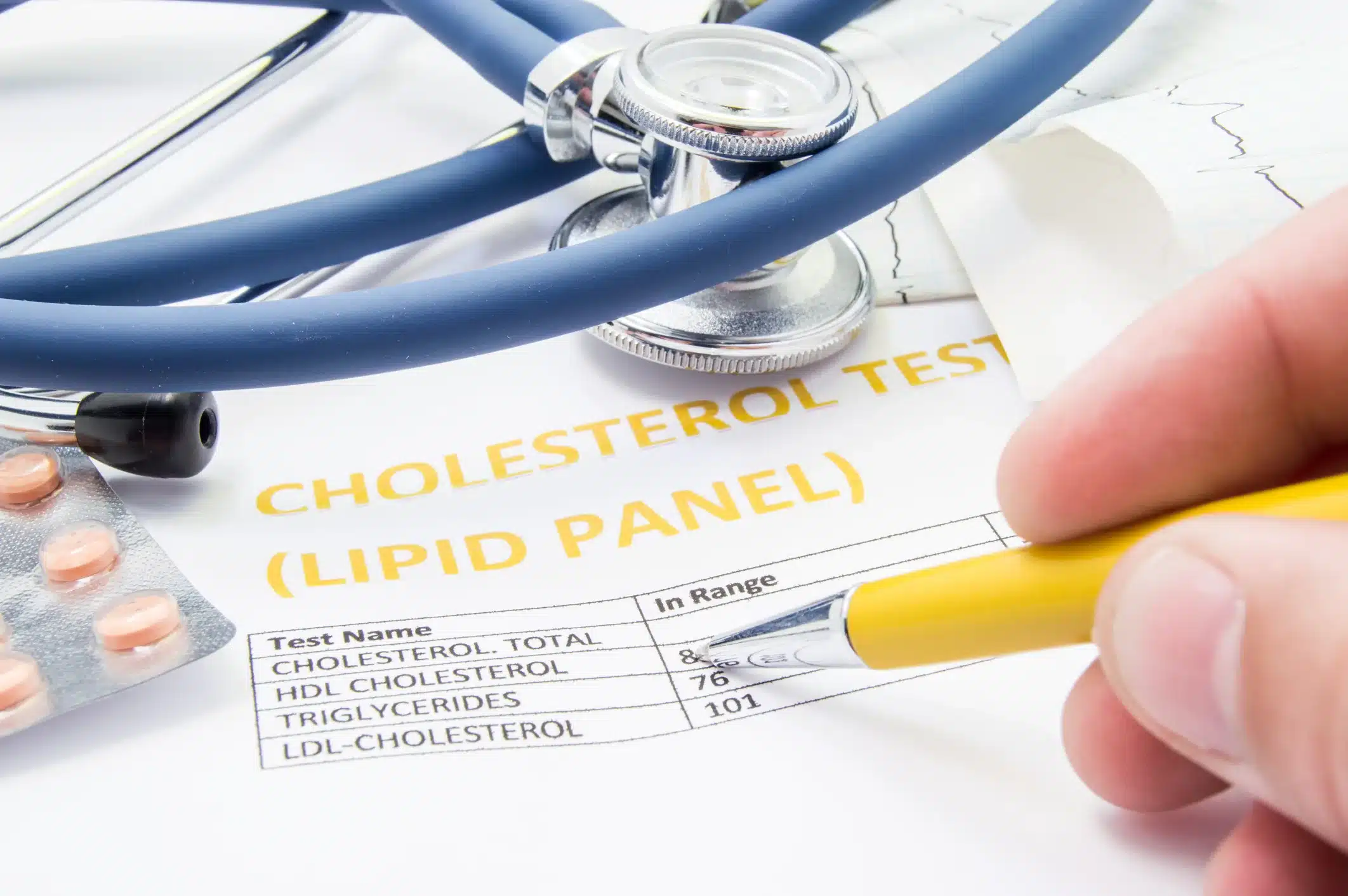
The results are in! But what does it all mean? MainStreet Family Care is breaking down how to read cholesterol levels and what they may indicate about your health.
You have seen your primary healthcare partner for your annual exam, and they recommend checking your cholesterol levels. Let’s talk about why you should check your cholesterol levels, how to prepare for your testing, and what the results may mean.
Why We Check Cholesterol Levels
Cholesterol is a naturally occurring substance produced by your liver and most cells in your body. It is a type of fat, also called a lipid, and is essential for your health and vitality. For example, you need cholesterol to:
- Build the structure of cell membranes and regulate what enters and exits your cells.
- Create necessary hormones, such as –
- Cortisol, which helps regulate your body’s response to illness and your metabolism.
- Epinephrine and norepinephrine, which prepare your body to respond in times of anxiety and stress.
- Estrogen and testosterone, your primary sex hormones.
- Help digest fatty foods through the production of bile.
- Produce vitamin D, which is a nutrient critical to your bone health, brain cell activity, energy level, hair growth, immune health, muscle function, and skin health.
Cholesterol is also found in animal food sources, such as dairy, eggs, meat, and seafood, as well as tropical oils like coconut and palm oil.
The problem is that too much cholesterol, called hyperlipidemia, can place you at higher risk for some significant health issues, including:
- Heart disease
- Kidney disease
- Peripheral artery disease (PAD)
- Stroke
Who Needs to Check Cholesterol Levels?
The American College of Cardiology and the American Heart Association recommend cholesterol testing for:
- Healthy children once between ages nine and eleven.
- Healthy adolescents once between ages 17 and 21.
- Children and adolescents with diabetes and obesity more frequently as advised by their healthcare provider.
- Healthy adults aged 20 and over every four to six years.
- Adults with diabetes, high blood pressure, obesity, tobacco use, or family history of heart disease and stroke more frequently as advised by their healthcare provider.
More than 94 million adults and 20 percent of adolescents in the United States have high cholesterol levels, increasing their risk of serious disease.
There are no signs or symptoms of high cholesterol levels. The only way to know if your cholesterol is elevated – and your risk of disease is increased – is to have a cholesterol test, also known as a lipid panel.
Is it time to have your cholesterol levels tested? MainStreet Family Care primary care services can help! Sign up to schedule an appointment today!
Preparing for Your Cholesterol Level Testing
Good news – no studying is required for this test! The not-so-good news for those who aren’t fans of needles is that your cholesterol testing is a blood test. Don’t panic! We’ll use a little needle; the stick and blood draw will be over before you know it.
Pro tip: Drink plenty of water the night before and the morning of your cholesterol testing (or any blood test) to prevent dehydration. This will help the phlebotomist (lab technician) find your vein more easily and save you from multiple pokes.
Your healthcare provider will likely advise you to fast for at least eight to 12 hours before your blood cholesterol testing. Some elements of the cholesterol test can be inaccurate if you have eaten recently. You can still drink water and take your routine medications during your eight to 12-hour fasting period.
You should refrain from drinking alcohol for at least 24 hours before your cholesterol testing. Alcohol can elevate some components of your lipid panel.
Reading Cholesterol Test Results
You’ve had your cholesterol tested. You open your patient portal when you see the test results, and there it is: a bunch of alphabet soup abbreviations with random numbers next to them.
Let’s translate all that gobbly-gook into something meaningful for you and your health.
Your cholesterol levels will be measured in milligrams (mg) of cholesterol per deciliter (dL) of blood, so you will see a number for each part of the lipid profile followed by “mg/dL.” Now, let’s look at each component of the lipid panel and what they mean.
HDL Cholesterol
High-density lipoprotein (HDL) is often called the “good” cholesterol. HDL circulates through your blood system, picks up excess cholesterol, and transports it to the liver to be removed from your body. It also has anti-inflammatory properties that can help decrease the size of inflammation and plaque in your arteries.
Higher HDL cholesterol levels are associated with lower heart disease and stroke risk. Current guidelines recommend an HDL of at least 40 md/dL or higher for men and at least 50 mg/dL or higher for women. These levels are thought to provide some protection against heart disease and stroke.
Some factors that can lead to HDL cholesterol levels being too low include:
- A sedentary lifestyle
- Diabetes
- Obesity
- Smoking
These are also individual risk factors for heart disease and stroke.
LDL Cholesterol
Low-density lipoprotein (LDL) is known as the “bad” cholesterol. However, remember that cholesterol is a necessary substance in our bodies. So, it’s not the LDL that is bad, but having too much LDL is bad.
Excess LDL levels can cause plaque buildup in your blood vessels. The plaque buildup narrows the passageway for your blood to flow to your vital organs, such as your brain, heart, and kidneys, increasing your risk of stroke, heart attack, and kidney disease.
Lower LDL cholesterol levels are associated with lower risk of heart disease and stroke. Current guidelines recommend an LDL level of 100 mg/dL or less for people with no other risk factors for heart disease or stroke and an LDL level of 70 mg/dL or less for people with risk factors such as diabetes.
Some factors that can lead to LDL cholesterol levels being too high include:
- A sedentary lifestyle
- Familial hypercholesterolemia (family history of high cholesterol)
- Obesity
- Smoking
- Unhealthy eating habits
Triglycerides
Triglycerides are the most common type of fat in your body. When you eat more calories than you need, your body stores them as triglycerides. Your body then releases triglycerides for energy when you need it.
A triglyceride level of 150 mg/dL or lower is recommended to decrease your risk of heart disease, stroke, and other health conditions.
Some factors that can increase your triglyceride levels include:
- Alcohol
- Poorly managed chronic diseases
- Processed foods
- Refined carbohydrates
- Some medications
- Sugar
Total Cholesterol
Your total cholesterol is the most straightforward value to explain and understand but the least valuable component of your lipid panel. It is precisely as it’s named – the total amount of cholesterol circulating in your bloodstream. It is the sum of your HDL plus your LDL and 20 percent of your triglycerides.
The current guideline recommends 150 mg/dL or lower total cholesterol as optimal, but 200 mg/dL or lower is still considered a healthy value. Total cholesterol between 200 and 239 mg/dL is considered borderline if you have no other heart disease or stroke risk factors and too high if you do have other heart disease or stroke risk factors. Total cholesterol levels of 240 mg/dL and above are considered dangerously high for everyone.
Why is this the least valuable component? This number does not tell us how much “good cholesterol” you have circulating in your blood vs. how much “bad cholesterol.” Healthcare providers rarely order a lab test of just your total cholesterol level because it does not provide enough information, and treatment cannot be recommended based on a total cholesterol level alone.
Interpreting Your Cholesterol Results
You generally want a low total cholesterol, LDL “bad” cholesterol and triglyceride level, and a high HDL “good” cholesterol level. However, it’s not that simple.
No lab test alone can tell the whole story of your health. Your healthcare provider will help you interpret your cholesterol results in the context of your:
- Age
- Family history
- Gender
- Medical History
- Risk factors
Turn to MainStreet Family Care
Is it time for your annual exam and lab testing? MainStreet Family Care primary care services can help!
Access your patient portal to schedule an appointment. We’re open seven days a week with extended hours and on-site lab testing, and we have multiple locations for your convenience. We can often schedule next-day appointments!






